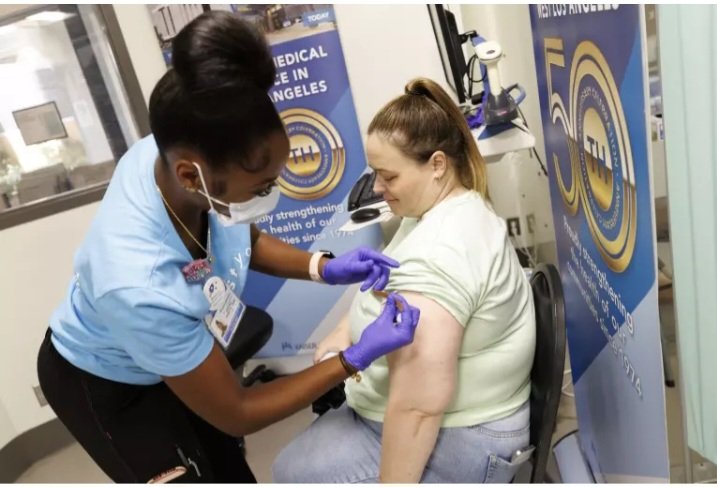In certain regions of California, COVID-19 seems to be spreading as a novel, highly contagious subvariant that causes “razor blade throat” symptoms abroad gains ground.
The new subvariant NB.1.8.1, dubbed “Nimbus,” has been reported in Chinese news outlets to exhibit more overt symptoms of “razor blade throat,” a condition in which patients report feeling as though their throats are dotted with razor blades.
The phrase “razor blade throat” may appear new, however it has previously been used in the United States to describe extremely severe sore throats linked to COVID-19, such as having a throat that feels like it is covered with glass fragments. However, this symptom is receiving more attention now that the Nimbus subvariant has led to COVID-19 outbreaks in other nations.
“I believe that the majority of patients initially presented with shortness of breath and the typical loss of taste and smell as the main symptom prior to Omicron,” said Dr. Peter Chin-Hong, an infectious disease specialist at UC San Francisco. However, “people are focusing on these other aspects of symptoms,” including an excruciatingly painful sore throat, while hospitalization for COVID has decreased.
Currently one of the most prevalent coronavirus subvariants in the country, Nimbus is a member of the Omicron family. An estimated 37% of the country’s coronavirus samples during the two weeks ending June 7 were Nimbus, which is currently about equal to the subvariant LP.8.1, which is likely to be in charge of 38% of the virus in circulation. According to the Centers for Disease Control and Prevention, LP.8.1 has been the most common over the last few months.
According to a state Department of Public Health communication to the Los Angeles Times, the Nimbus subvariant has also been rising in California since May. According to projections, 55% of the virus that is circulating in California is the Nimbus subvariant, compared to only 2% in April, the FDA stated on Friday.
“The rise of the NB.1.8.1 variant, increased coronavirus levels in wastewater, and an increase in the test positivity rate are some indicators of increased COVID-19 activity,”Kaiser Permanente Southern California’s regional chief of infectious diseases, Dr. Elizabeth Hudson, sent an email to The Times.
Variability is evident in wastewater surveillance throughout Southern California: San Bernardino is experiencing high activity, Ventura and Los Angeles counties are reporting low-to-moderate levels, Riverside is reporting low levels, and Santa Barbara watersheds are reporting moderate-to-high levels, according to Hudson.
The local Department of Public Health told The Times that although viral concentrations are still low, coronavirus levels in sewage have increased in Los Angeles County. Compared to a similar period a few weeks prior, virus levels in wastewater increased by 13% during the week ending May 30 — the most recent available.
Additionally, the number of positive COVID surveillance test results in L.A. County has slightly increased. The percentage of COVID surveillance tests with positive results for infection increased from 3.8% in early May to 5% in the most recent week. Los Angeles County continues to have a low number of ER visits connected to COVID.
According to the local Department of Public Health, San Francisco’s COVID-19 sickness rates were still modest.
However, in Santa Clara County, the most populated county in Northern California, coronavirus levels in wastewater are beginning to rise, “just as they have over past summers,” the local Public Health Department told The Times via email. Coronavirus levels in San José’s sewershed were deemed “high” as of Friday. Sunnyvale had “low” viral levels, while Palo Alto had “medium” levels. The most prevalent subvariant in the county is nimbus.
According to the state Department of Public Health’s website, coronavirus levels in wastewater are at a “medium” level throughout California; the last time they were consistently “low” was in April.
According to a Friday email to The Times, the California Department of Public Health stated that “seasonal increases in disease levels are likely in the future.”
The COVID-19 outbreak coincides with protests by numerous medical professional associations and state and local health officials against recent vaccine policy actions by the Trump administration, which some experts believe will make it more difficult for people to receive the COVID-19 and other vaccines.
The CDC’s official recommendations to suggest the COVID vaccine for all individuals aged 6 months and older were lowered by federal officials in May.
The CDC now advises parents of healthy children to see a healthcare professional before requesting that their children receive the COVID vaccination, and it provides “no guidance” on whether healthy pregnant women should receive it.
The fluctuating vaccine recommendations for expectant mothers were criticized by the American College of Obstetricians and Gynecologists, who blamed the U.S.
Department of Health and Human Services — under the leadership of Robert F. Kennedy Jr., the vaccine skeptic secretary — of “propagating misinformation.” The American Pharmacists Association stated that the scientific information presented in recent years did not seem to support the removal of the immunization advice for expectant mothers.
Additionally, in an open statement, 30 health-related groups, including the American Medical Association, stated that “we must continue to prioritize high levels of COVID-19 vaccine coverage in pregnant patients to protect them and their infants after birth.”
Pregnant women should get immunized “one million percent,” according to Chin-Hong.
“It is very evident from the data that pregnant women who did not receive the COVID vaccination had a higher rate of complications, hospitalization, and preterm births than those who did,” said Dr. Yvonne Maldonado, an infectious disease specialist at Stanford University. According to her, the immunizations also benefit babies because the mother’s antibodies can transcend the placenta and shield the child for a predetermined period of time.
Given that neonates cannot receive vaccinations before six months of age, Maldonado stated that this is crucial protection. According to Maldonado, the rates of hospitalization for infected neonates are comparable to that of people 65 and older.
Then, this week, Kennedy abruptly dismissed every member of a powerful committee that provides the CDC with vaccine policy advice. Kennedy said that the former members of the 1964-founded Advisory Committee on Immunization Practices were “plagued with persistent conflicts of interest and has become little more than a rubber stamp for any vaccine” in an opinion piece published in the Wall Street Journal.
Among those dismissed as vaccine consultants was Maldonado, a professor of pediatric infectious diseases and epidemiology. She referred to their mass termination as unprecedented in the ACIP’s history.
Maldonado declared, “We are definitely in uncharted territory here.” “I believe it will be quite challenging to comprehend the future of vaccines…. Additionally, they will go over the complete vaccine schedule.
Regular assessments of vaccination schedules are generally beneficial, and previous evaluations have found that the currently advised vaccinations are both safe and effective, according to Maldonado. But, given some of the false information that has been spread regarding some of these vaccines, the standards being promoted by freshly appointed government officials “may actually wind up refusing to recommend, say, measles vaccine or HPV vaccine.”
Maldonado stated, “And we might end up losing some of these vaccines if any of that is taken as fact.”
“It is difficult to predict if those vaccines would vanish,” she stated. However, it’s also feasible that federal authorities would start to withhold funds for some vaccinations that are given to kids from low-income households.
Kennedy described the committee as a rubber stamp for vaccine manufacturers, but she disagreed. “Usually, a decision to forego a vaccine is made long before a vote is held,” Maldonado stated.
Kennedy’s firing of the vaccination experts was denounced as “deeply troubling for the health of the nation” in a joint statement by the governors of California, Oregon, and Washington. The governors also supported the fired advisors, claiming they had been “carefully screened for major conflicts of interest.”
Governor Gavin Newsom said in a statement Thursday, “We will continue to work together to ensure that science and sound medicine prevail to prevent any loss of life, and we have serious concerns about the integrity and transparency of upcoming federal vaccine recommendations.”
Historically, the CDC director has accepted the advisory committee’s recommendations regarding vaccinations.
According to Chin-Hong of UC San Francisco, “it was one of the most depressing weeks in American health… a dark period for everyone right now, and demoralizing.” “That is really destabilizing.”
The administration’s purging of the vaccine advisors was described by the American Academy of Pediatrics as “an escalating effort to silence independent medical expertise and stoke mistrust in lifesaving vaccines.” According to the Associated Press, Kennedy personally selected several of his replacements who have a history of opposing vaccines.
The L.A. County Department of Public Health noted in a statement that the mass firing “probably puts vaccine access and insurance coverage at serious risk.” “It undermines confidence in the recommended vaccination schedule, not only among the general public but also among healthcare professionals who depend on the ACIP for objective, scientific advice.”
California, Oregon, and Washington public health departments stated that they “remain committed to the recommendation that all individuals aged 6 months and older should have access to and the option to receive currently authorized COVID-19 vaccines, with a focus on protecting higher risk individuals, such as infants and toddlers, pregnant individuals, and others with risks for serious disease.”
According to a statement from the L.A. County Department of Public Health, “At this time, the COVID-19 vaccine is still covered by insurance in Los Angeles County, and the current vaccination recommendations for individuals 6 months and older to receive the COVID-19 vaccine remain in effect.”





